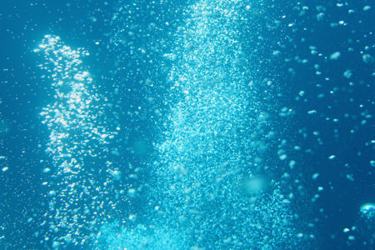Lake Stratification And Nanobubble Generators
By Nick Dyner, CEO of Moleaer

If you’ve ever jumped in a lake during the summer and felt warmer water on the surface and as you sunk deeper, you felt the cooler water at the bottom, you experienced the effects of thermal stratification. Though this is natural, imagine you go to jump in the lake and it has a thick layer of algae growing and it smells. Would you still jump in?
As lake owners and stewards, we want to keep our lakes healthy, clean, and virtually odor-free. We also want to swim, fish, and recreate on and near our lakes. In order to keep our lakes healthy and inviting, we must understand lake stratification and its effects on lake health.
What Is Lake Stratification?
Lake stratification is naturally occurring and happens when water divides into layers with different temperatures with warmer water near the surface and colder water in deeper areas. Water density is dependent on water temperature and water with different densities do not mix well. As air temperatures rise in the spring, temperatures at the top of the lake rise as well. This causes more definition in thermal stratification. Thermal layers become more prevalent and mixing is not possible, resulting in the dissolved oxygen (DO) being trapped near the surface and less DO available at the deeper, cooler levels.
Though stratification is a natural process in lake ecosystems, if some lake management principles are not administered, the decreased DO may lead to increased algae growth and less favorable conditions for fish and other aquatic organisms. The absence of oxygen, or anoxia, causes the production of harmful gases such as methane and hydrogen sulfide (H2S) and can also indirectly lead to algae growth.
Low DO levels lead to:
- Increased algae growth
- Slower decomposition and the buildup of organic sediment
- Increased nutrient release from sediment into the water column
- Fish suffocation due to lack of oxygen
- Anaerobic bacteria growth causing odors and greenhouse gases
In natural lakes, bacteria in the sediment are working diligently to break down decaying organic matter. In the presence of DO, they can do this quickly and efficiently, but without DO they do this slowly and often produce malodors such as H2S (which is also toxic to fish), greenhouse gasses (such as methane), and — worst of all — when the nutrient concentration in the lake exceeds the microbiome’s capacity, these excess nutrients will also likely cause an increase in algae growth, which can be harmful to the health of wildlife, humans, and the overall ecosystem.
As humans develop and create their own watersheds, the natural process can become problematic. In our man-made and developed watersheds with paved surfaces and gutters, surface runoff containing fertilizers, nutrients, and pollution runs unfiltered into our waterways. These increased nutrients in the water column exceed the ability of bacteria to consume them, resulting in unhealthy lake conditions, increased algae growth, malodorous conditions, and fish suffocation due to lack of oxygen.
Nanobubbles Are The Best Way To Improve Lake Health
Stratification in lakes is important for aquatic life. For example, fish prefer to be in the cooler temperatures at the bottom of the lake, though they need oxygen to survive. It becomes a problem when DO is unavailable in the deeper levels of the lake because thermal layers aren’t mixing and/or the DO demand is too high from excess nutrients. There are ways to increase DO in lakes without disrupting the natural stratification process.
It’s common lake management practice to use some type of aeration or circulation system to get oxygen into the lower levels of the lake where fish and other organisms need it to survive. These management solutions often have drawbacks. In fact, traditional destratification aerators utilize larger, very buoyant bubbles that rise and mix water without transferring nearly any oxygen at all. Additionally, these systems destratify a lake, increasing overall water temperature and negatively impact aquatic life that depends on cooler water temperatures. Unlike traditional aerators, nanobubbles are the exact opposite. They don’t mix the water because they don’t rise to the surface and dissolve slowly resulting in efficient oxygen transfer.
Research has shown that nanobubbles are a unique new way to increase DO levels without disrupting the natural stratification process. Nanobubbles not only transfer oxygen directly to the sediment and throughout the lake, but they also have unique properties that can break down organic contaminants, too. This can actually reduce the oxygen demand in your lake, freeing it up for fish and other living organisms to use. Also, because nanobubbles are neutrally buoyant, they distribute from a single discharge point without the need for additional pipes, hoses, and diffusers like conventional systems. As the images demonstrate, these units can be installed right from shore with only a few short lengths of pipe.
Benefits of nanobubbles:
- Enhance nature’s natural oxidative processes
- Act like an oxidant to kill and prevent algae blooms
- Sustainable and chemical-free
- Transfer oxygen directly to sediment and the entire lake
- Doesn’t disrupt natural stratification
- Breakdown unwanted organic compounds
- Positively affect oxidation-reduction potential (ORP) — the ability of a lake or river to cleanse itself or break down waste products, such as contaminants and organics
As opposed to traditional aeration systems, when installing a nanobubble system, a lake manager can choose to disrupt or not disrupt the natural stratification process. This allows the lake manager to have more control over lake conditions, which are often site-specific.
Lake stratification is natural and necessary to lake health, though lack of DO at deeper depths can pose problems. Using nanobubbles to add DO back in the water and maintain thermal stratification is the best way to promote healthy lakes.
